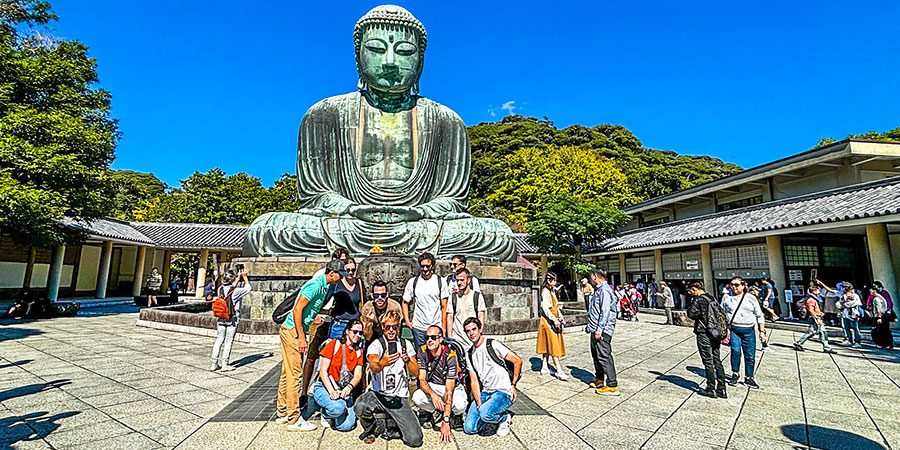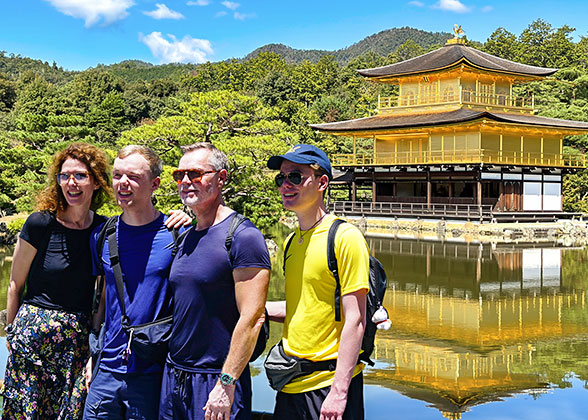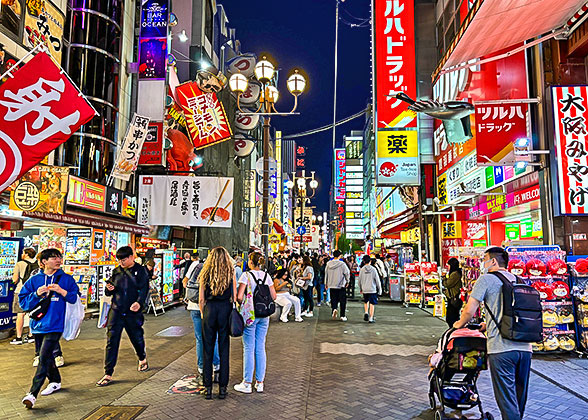Kamakura Daibutsu
Kamakura Daibutsu or the Great Buddha in Kotoku-in Temple is the second-highest copper Buddha statue in Japan. Built in 1252, the statue is 11.3 meters high (37 feet) and weighs about 121 tons (266,759 pounds), sitting on a base about 2.05 meters high (6.73 feet). It is always praised for its well-preserved original appearance: the relatively flat face, comparatively low bun, and leaning-forward body. Such style of Buddha statues was very popular in the Kamakura Period (1185 – 1333), therefore this Great Buddha statue is also regarded as the symbol of Kumakura and listed as a national treasure in Japan. In addition, Kamakura Daibutsu is the film location of the Japanese anime movie, Slam Dunk. Apart from the huge copper statue, there are also some other valuable buildings around the statue, such as the Kangetsu-do Hall and the Nio-mon Gate.

Visitors before Kamakura Daibutsu
|
Kamakura Daibutsu is Hallow.
Kamakura Daibutsu is hollow and visitors are allowed to enter it. You can see countless traces of repairing, which witnessed the damage this statue suffered from natural disasters in the past hundreds of years. Note that in summer, the interior of the statue may not be open to visitors due to high temperatures, so please check the weather in advance before coming.
|
|
|
In addition, the Restroom on the left of the statue collects a pair of huge warazori (grass shoes), which are 1.8 meters long (6 feet), 0.9 meters wide (3 feet), and weighs 45 kilograms (100 pounds). Every three years, a new pair of warazoris would be made by children in a club and donated to the temple. Such tradition dated back to 70 years ago as people then wished that the Buddha could step on each corner of Japan.
Others to See in Kotoku-in Temple
1. Nio-mon Gate
The Nio-mon Gate was built in the 18th century. On both sides of the Gate stand two Nio statues that protect the temple. One painting of Kwan-yin Bodhisattva which dates back to the Edo Period (1603 – 1867) is displayed here.

Nio-mon Gate in Kamakura Daibutsu
|
2. The Kangetsu-do Hall
The Kangetsu-do Hall was built in the 15th century and the most worth-seeing relic here is the standing statue of Avalokiteshvara Bodhisattva.3. Pink Sakura and Red Maple Leaves
The most recommended times to visit Kamakura Daibutsu are spring and autumn, especially months April and October, as in the Kotoku-in Temple grow 50 Sakura trees and many maple trees around Kamakura Daibutsu. It is the best time to take scenic photos.Ticket Prices
300 yen for entering the Temple;20 yen more for visiting the interior of the Buddha Statue.
Opening Hours
Kotoku-in Temple
April – September: 8:00 a.m. – 5:30 p.m.October – March: 8:00 a.m. – 5:00 p.m.
The last entry time is 15 minutes before the Temple is closed.
Interior of the Kamakura Daibutsu
Visitor can visit the interior of the statue from 8:00 a.m. to 4:30 p.m., but the last entry time is 4:20 p.m.How to Get to Kamakura Daibutsu
1. Electric Railway
Take the Enoshima Electric Railway bound for Fujisawa, get off at Hase Station, walk northward for 450 meters, and you will reach there.2. Bus
Take the Enoshima-dentetsu Bus at bus stop #1 or the Keikyu Bus at bus stop #6 and get off at the Daibutsu-mae stop. Kotoku-in is on your northeast and you can walk there in 1 minute.Nearby Tourist Attraction
1.Kamakura Hasedera
Kamakura Hasedera is about 550 meters (600 yards) away from Kamakura Daibutsu. This temple was built in the 8th century. In the Temple, a 1,300-year-old wooden statue of Avalokiteshvara Bodhisattva with 11 faces is shrined. It is about 10 meters high (33 feet) and is the tallest wooden statue in Japan. The museum in the temple displays many other statues and ancient books that introduce the temple’s history. From January to December, there would always be flowers in the temple, such as Sakura in April, lotus in July, Persicaria capitata in October, and senryo in December.
2. Tsurugaoka Hachimangu Shrine
As one of the three major Hachimangu Shrines, Tsurugaoka Hachimangu
Shrine the patron saint of samurais is worshipped. Here, you can see 9 shrine
buildings where different wishes can be made. The national treasures displayed,
the 1,000-year-old gingko tree, and peonies in the one of the three most
beautiful gardens in the Shrine will provide you a visual feast for you. If
lucky, you may watch monthly ritual celebrations.




